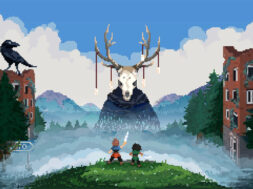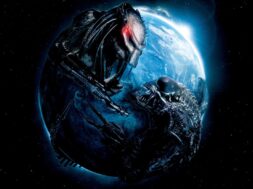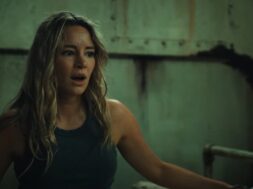It Came From the ‘80s is a series that pays homage to the monstrous, deadly, and often slimy creatures that made the ‘80s such a fantastic decade in horror.
Getting a movie made is no small feat, but sometimes, in cases where every obstacle that can pop up does, it can be akin to performing a miracle. Such is the case with Neon Maniacs, a mess of a monster movie rife with production woes. In an era of practical effects-driven horror prone to sequel fever, a horror movie about a horde of varied monsters seemed like a safe bet for franchise potential. Even a schlocky one; horror has a built-in fanbase, after all. Despite a cool concept, the muddled title, incoherent narrative, and financial troubles sentenced this bizarre movie to near obscurity.
The setup is simple enough; monsters from another dimension have taken up residence inside the Golden Gate Bridge by day. At night, they emerge to slaughter. When a group of friends hanging out at a nearby park falls prey to the creatures, only Natalie (Leilani Sarelle) survives. Naturally, the police don’t believe her story, and she’s ostracized at school. She teams up with new love interest Steven (Clyde Hayes) and young horror fan Paula (Donna Locke) to keep the monsters at bay.
Penned by Mark Patrick Carducci, who would go on to co-write the screenplay for Pumpkinhead, Neon Maniacs was nothing if not ambitious. As in, the initial script was broader in scope and featured twenty-seven Maniacs. Budgetary constraints prompted that number cut down to twelve; Ape, Archer, Axe, Decapitator, Doc, Hangman, Juice, Mohawk, Punk Biker, Samurai, Slasher, and Soldier. They also come accompanied by two little cyclops-lizard creatures called Scavengers. Because the film spends a lot of time with the human protagonists, most of the Maniacs get minimal screen time. For the monsters that resemble mutated Village People, that’s not always a bad thing. Considering the movie’s title, though, they should’ve been more prominent.

Instead, Neon Maniacs spends a lot of time setting up the romance between Natalie and Steven, likely a big deal because she’s a virgin and, therefore, a “pure” target for the Maniacs. That’s isn’t something the final product makes all that clear, though. It probably also explains why the lengthy climax at the school’s Battle of the Bands dance ends in anticlimactic fashion. Spoiler alert: After the Maniacs descend and attack, Steven and Natalie hide in a darkened classroom and figure that’s the perfect time to have sex. While at least one monster is searching for them, I guess once Natalie is no longer a virgin, the remaining monsters shrug their shoulders and wander back home. Paula is pretty much a third wheel, an outsider whose passion for horror somehow makes her the first to discover that the monsters’ weakness is water. Therefore, living at the Golden Gate Bridge is a risky move. The movie is full of strange decision-making that may have made sense in initial drafts but became nonsensical during its hacked-up production.
As for the title, Carducci explained in an interview in Fangoria issue #47 that, “The neon part is a coined term. It’s a new name for new monsters.” Also adding, “There’s also a sort of electric, almost punk energy to them.” In other words, an explanation that makes more sense in theory than in practice. It is a catchy title, however.
Special makeup effects were designed and created by Allan A. Apone (The Avengers, Friday the 13th Part III) and Douglas J. White (The Return of the Living Dead, Candyman: Farewell to the Flesh). Their crew, from their SFX shop Makeup Effects Lab, had a lot on their plate with thirteen distinct creature designs on a meager budget, but it was exacerbated by a sudden 3-month halt in production midway through the shoot, thanks to financial woes. When production finally resumed, many of the actors playing various Maniac roles didn’t return. So, the MUFX crew had to reapply foam latex appliances that had been fitted for those actors on new replacements. Anytime the Maniacs were doused in water, they melted. Makeup effects artist Shannon Shea hilariously details what it was like working on this effect in his book I’m Rubber, You’re Glue, recounting that one of the notable monster deaths was simply cotton candy packed around a skeleton. “The water hit the cotton candy, and it did melt into bright pink and blue rivulets, but was it successful? Who could tell? It was a low-budget movie entitled Neon Maniacs for corn’s sake; did it matter? (pg. 161)”

It wasn’t just Maniac actors that departed during the hiatus; cinematographer Oliver Wood had moved on as well. That meant director Joseph Mangine, an experienced D.P., stretched himself further by pulling double duty. Mangine never directed again after this, but he did continue his work in cinematography.
Once production finally completed, the film then sat shelved for a couple of years before finally seeing a small theatrical release in 1986. That final hook meant to tease a sequel never happened, much to the disappointment of its devout followers. But sometimes that’s for the best. Neon Maniacs should be a horror fan’s dream. A bunch of rampaging monsters running amok in a city? Yes, please. Instead, it’s a bunch of quick shots of various monsters that grin and grunt at each other, but we never get to see much of their personalities beyond that. That screen time is dedicated to a trio of humans that don’t offer much rooting interest. As it stands, it’s the precise type of horror movie that makes you wonder about what could’ve been. Neon Maniacs belongs in the same category as films like Spookies, a film whose tumultuous behind-the-scenes stories prove far more interesting than what ended up on screen.









